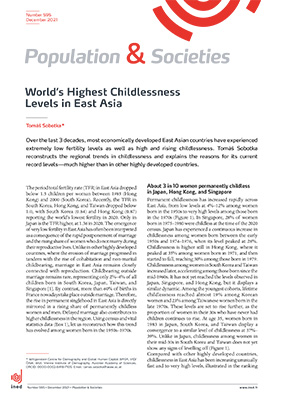World’s Highest Childlessness Levels in East Asia
Press release Published on 06 December 2021

Author: Tomáš Sobotka
Over the last 3 decades, most economically developed East Asian countries have experienced extremely low fertility levels as well as high and rising childlessness. Tomáš Sobotka reconstructs the regional trends in childlessness and explains the reasons for its current record levels—much higher than in other highly developed countries.
In recent decades, most economically developed East Asian countries have experienced extremely low fertility levels as well as high and rising childlessness. In Japan, Hong Kong, and Singapore, about 3 out of 10 women born in the mid-1970s remain permanently childless.
This phenomenon is closely associated with the decline in marriage and the rise of lifetime singlehood, and with more married women remaining without children. Among women born in the 1960s and 1970s, rising childlessness accounts for about two-thirds of cohort fertility decline in Japan, Hong Kong, and South Korea. Future childlessness trends will also depend on the way East Asian societies adapt to the ‘gender revolution’ and changing family patterns.
Key factors include greater gender equality, a greater focus on well-being among children and families, better economic prospects for young adults, and labour market reform to ensure women no longer have to choose between career and motherhood.
Published on: 08/12/2021








